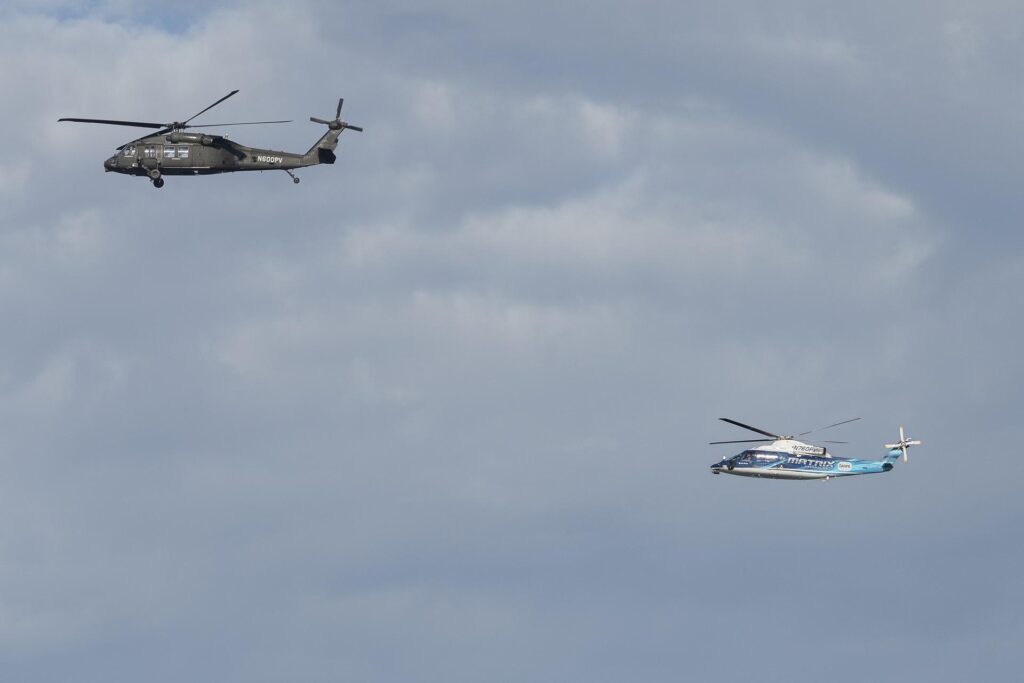NASA pilots along with Sikorsky safety pilots flying Sikorsky’s Black Hawk Optionally Piloted Vehicle, left, and SARA S-76B over Long Island Sound Thursday, Oct. 26, 2023. image: NASA/Steve Freeman
Revolutionizing Urban Air Mobility: NASA, Sikorsky, and DARPA’s Leap into Autonomous Flight Technology
by DRONELIFE Contributing Editor Paul Rossi
Don’t miss Paul with co-pilots Terry and Samuel on the new Weekly Wings podcast! Drone news from the pilot perspective.
NASA’s relentless pursuit of technological innovation has reached a new milestone with its recent collaboration with Sikorsky and DARPA. This joint effort is pioneering autonomy software that promises to significantly enhance the safety and reliability of air taxi flights. At AUVSI Xponential 2024, I had the pleasure of speaking with Scott Howe, a distinguished NASA test pilot, to delve deeper into this groundbreaking project.
Pioneering Autonomy Software: Core Functionalities and Impact
Scott explained that NASA developed specific autonomy software tailored for Sikorsky helicopters, which focuses on two crucial functionalities: Long Range Flight Path Management and Hazard Perception Avoidance. “The software manages long-range flight paths to strategically deconflict flight routes, ensuring safety and efficiency,” Howe noted. “Moreover, it provides a 360-degree awareness around the vehicle, detecting and avoiding immediate hazards, which is pivotal in ensuring operational safety.”
The implementation of such advanced software in Sikorsky helicopters marks a significant advancement in autonomous flight technology. This is especially crucial as urban air mobility continues to evolve, where the complexity of navigating densely populated environments poses numerous challenges.
Enhancing Safety in Urban Air Mobility
The impact of NASA’s autonomy research extends far beyond just technological prowess; it significantly enhances the safety and reliability of future air taxi operations. “Urban environments will greatly benefit from the data collected through these tests,” Howe emphasized. The software not only helps in managing intricate flight paths but also ensures that the air taxis can operate safely amidst the myriad of urban infrastructures.
Key Findings from the Autonomous Flights over Long Island Sound
During our discussion, Howe highlighted the key findings from the recent autonomous flights over the Long Island Sound. “These tests have proven that helicopters can serve as effective surrogates in collecting initial data sets, which are essential for advancing the development of electric vertical take-off and landing (eVTOL) vehicles,” he stated. This data is crucial for refining flight models and operational protocols, setting the stage for more comprehensive future tests.
For enthusiasts and professionals following DroneLife.com, Howe shared an important message about the ongoing research: “There is a tremendous excitement building around the future of drones of all sizes. The combination of advanced technologies and evolving policies are fostering significant growth in the industry.” He urged readers to stay informed and excited about the upcoming developments, as they promise to revolutionize the way we perceive and utilize drones in various sectors.
In conclusion, the collaboration between NASA, Sikorsky, and DARPA is not just about advancing autonomous flight technologies but is also a significant step towards safer, more efficient urban air mobility. As this project progresses, it will undoubtedly provide valuable insights and set new standards for the future of autonomous flying.
Read more:
Paul Rossi, US Army Veteran, is the President at Nine Ten Drones, a N. C.-based drone services company, training center, and reseller. A graduate of Embry Riddle Aeronautical University (ERAU) and the U.S. Army Aviation Logistics School, Rossi is passionate about the aviation industry. He holds both a Private Pilot’s License w/ Instrument Rating for manned aircraft and a Part 107 Remote Pilot’s Certificate. Rossi is currently studying for his MS Space Operations from ERAU, energized to expand his reach beyond Earth’s atmosphere. You can see more videos and product information on the Nine Ten Drones YouTube channel and connect with Paul on LinkedIn.com
Miriam McNabb is the Editor-in-Chief of DRONELIFE and CEO of JobForDrones, a professional drone services marketplace, and a fascinated observer of the emerging drone industry and the regulatory environment for drones. Miriam has penned over 3,000 articles focused on the commercial drone space and is an international speaker and recognized figure in the industry. Miriam has a degree from the University of Chicago and over 20 years of experience in high tech sales and marketing for new technologies.For drone industry consulting or writing, Email Miriam.
TWITTER:@spaldingbarker
Subscribe to DroneLife here.

